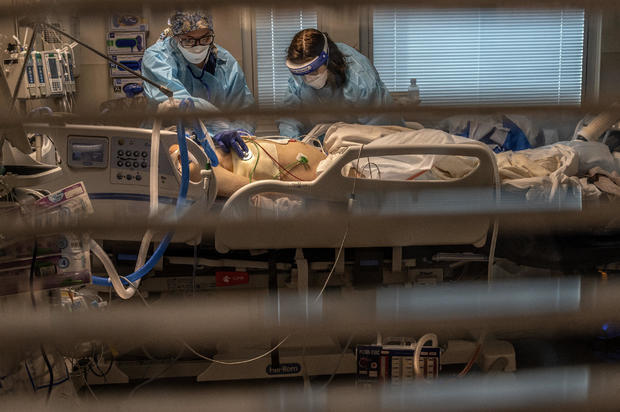[ad_1]
California became the first state to surpass the grim mark of two million COVID-19 cases Wednesday, just six weeks after hitting the one million mark, according to data from Johns Hopkins University. California’s infection rate — in terms of the number of cases per 100,000 people — is lower than the U.S. average but, with 40 million residents, it outpaces other states in sheer numbers.
More than 23,500 Californians have died from the virus since the pandemic began.
The state has seen its number of cases climb exponentially in recent weeks, followed by soaring rates of hospitalizations and deaths that have overwhelmed intensive care units and prompted hospitals to put emergency room patients in tents and treat others in offices and auditoriums.
Pleas to avoid social gatherings for the holidays rang with special desperation in Southern California. Los Angeles County is leading the surge, accounting for one-third of the COVID-19 cases in the state and nearly 40% of its deaths.
“We know that this emergency is our darkest day, maybe the darkest day in our city’s history,” Los Angeles Mayor Eric Garcetti said as he urged people to cancel plans for holiday gatherings.
Renee C. Byer/The Sacramento Bee via AP, Pool
On Wednesday, the county reported its highest death toll and hospitalizations in a single day since the pandemic began, with 145 deaths and more than 6,000 people in hospitals. More than 9,000 people have died from COVID-19 in the county.
Orange County again set a record Wednesday for hospitalizations with 1,854, reports CBS Los Angeles. The county also reported 4,406 new coronavirus cases and two additional deaths.
Dozens of nurses picketed Wednesday morning across Orange County, protesting deteriorating conditions inside hospitals that have been brought to a breaking point due to the exponential spike in coronavirus cases, the station said.
Thanksgiving gatherings in California in which people ignored mask-wearing and social-distancing rules have been blamed for spreading the infection and another surge from the Christmas holidays could push stressed medical systems over the brink, officials are warning.
Medical workers are discouraged and outraged over scenes of crowded outdoor malls, packed parking lots, and parents and children walking around without masks, county Health Services Director Dr. Christina Ghaly said.
If L.A. County continues to see the same growth in COVID-19 infections in the next two weeks, hospitals may find themselves having to ration care because of a lack of medical staff, Garcetti said. “That means the doctors will be forced to determine who lives and who dies,” he said.
Santa Clara County, near San Francisco, was down to 35 ICU beds, putting hospitals dangerously close to rationing care, said Dr. Ahmad Kamal, the county’s director of health care preparedness.
Overall, California on Wednesday recorded the second-highest number of deaths, at 361. The number of coronavirus patients in intensive care units nearly doubled in just three weeks, to 3,827 cases, while the state’s ICU capacity fell to 1.1%, down from 2.5% just two days ago. The number of hospitalizations jumped to 18,828 patients, more than double since Dec. 1, with 605 new patients in one day.
Yet there were slight but encouraging signs of hope.
The transmission rate – the number of people that one infected person will in turn infect – has been slowing for nearly two weeks. The rate of positive cases reached a new high of 12.3% over a two-week period but was starting to trend down over the last seven days, from a peak of 13.3% to 12.6%.
The number of new positive cases dropped to a relatively modest 39,069, given that California has been averaging nearly 44,000 newly confirmed cases a day.
The state also had nearly 1,000 health workers assisting at 91 facilities in 25 of the state’s 58 counties, and is opening a fifth alternative care site in San Diego County.
The California National Guard was setting up about 200 beds on vacant floors of the Palomar Health Center near San Diego, within the existing hospital complex, said Brian Ferguson, a spokesman for the Governor’s Office of Emergency Services. It could begin accepting patients Christmas Day, relieving overburdened hospitals particularly in nearby Imperial County.
California expects more federal medical workers to arrive by the weekend, and Gov. Gavin Newsom said he expects more of the 3,000 contract health care workers the state is seeking to arrive after the holidays.
The governor also said more than 128,000 doses of vaccines had been administered as of Tuesday, another encouraging sign beyond the modest decline in the transmission rate.
But Newsom also warned that any progress could dissipate quickly, leading to the nearly 100,000 hospitalizations some models project in one month if people don’t heed calls to avoid holiday gatherings, particularly indoors.
“This virus loves social events,” Newsom said. “This virus thrives in that atmosphere.”
[ad_2]
Source link
